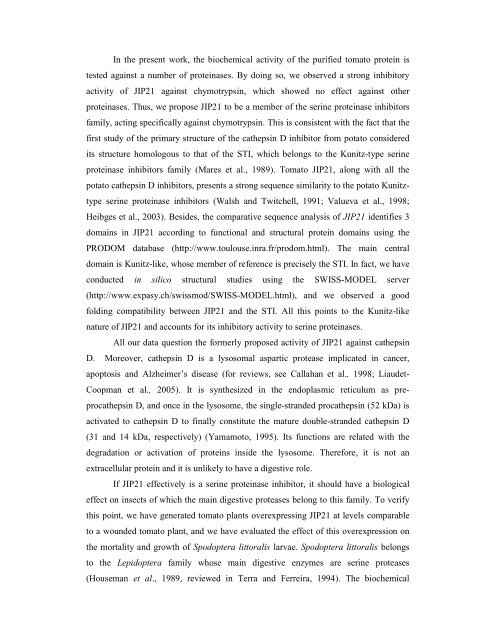Tomato CDI as a Strong Chymotrypsin Inhibitor ... - Plant Physiology
Tomato CDI as a Strong Chymotrypsin Inhibitor ... - Plant Physiology
Tomato CDI as a Strong Chymotrypsin Inhibitor ... - Plant Physiology
You also want an ePaper? Increase the reach of your titles
YUMPU automatically turns print PDFs into web optimized ePapers that Google loves.
In the present work, the biochemical activity of the purified tomato protein is<br />
tested against a number of protein<strong>as</strong>es. By doing so, we observed a strong inhibitory<br />
activity of JIP21 against chymotrypsin, which showed no effect against other<br />
protein<strong>as</strong>es. Thus, we propose JIP21 to be a member of the serine protein<strong>as</strong>e inhibitors<br />
family, acting specifically against chymotrypsin. This is consistent with the fact that the<br />
first study of the primary structure of the cathepsin D inhibitor from potato considered<br />
its structure homologous to that of the STI, which belongs to the Kunitz-type serine<br />
protein<strong>as</strong>e inhibitors family (Mares et al., 1989). <strong>Tomato</strong> JIP21, along with all the<br />
potato cathepsin D inhibitors, presents a strong sequence similarity to the potato Kunitztype<br />
serine protein<strong>as</strong>e inhibitors (Walsh and Twitchell, 1991; Valueva et al., 1998;<br />
Heibges et al., 2003). Besides, the comparative sequence analysis of JIP21 identifies 3<br />
domains in JIP21 according to functional and structural protein domains using the<br />
PRODOM datab<strong>as</strong>e (http://www.toulouse.inra.fr/prodom.html). The main central<br />
domain is Kunitz-like, whose member of reference is precisely the STI. In fact, we have<br />
conducted in silico structural studies using the SWISS-MODEL server<br />
(http://www.exp<strong>as</strong>y.ch/swissmod/SWISS-MODEL.html), and we observed a good<br />
folding compatibility between JIP21 and the STI. All this points to the Kunitz-like<br />
nature of JIP21 and accounts for its inhibitory activity to serine protein<strong>as</strong>es.<br />
All our data question the formerly proposed activity of JIP21 against cathepsin<br />
D. Moreover, cathepsin D is a lysosomal <strong>as</strong>partic prote<strong>as</strong>e implicated in cancer,<br />
apoptosis and Alzheimer’s dise<strong>as</strong>e (for reviews, see Callahan et al., 1998; Liaudet-<br />
Coopman et al., 2005). It is synthesized in the endopl<strong>as</strong>mic reticulum <strong>as</strong> preprocathepsin<br />
D, and once in the lysosome, the single-stranded procathepsin (52 kDa) is<br />
activated to cathepsin D to finally constitute the mature double-stranded cathepsin D<br />
(31 and 14 kDa, respectively) (Yamamoto, 1995). Its functions are related with the<br />
degradation or activation of proteins inside the lysosome. Therefore, it is not an<br />
extracellular protein and it is unlikely to have a digestive role.<br />
If JIP21 effectively is a serine protein<strong>as</strong>e inhibitor, it should have a biological<br />
effect on insects of which the main digestive prote<strong>as</strong>es belong to this family. To verify<br />
this point, we have generated tomato plants overexpressing JIP21 at levels comparable<br />
to a wounded tomato plant, and we have evaluated the effect of this overexpression on<br />
the mortality and growth of Spodoptera littoralis larvae. Spodoptera littoralis belongs<br />
to the Lepidoptera family whose main digestive enzymes are serine prote<strong>as</strong>es<br />
(Houseman et al., 1989, reviewed in Terra and Ferreira, 1994). The biochemical

















